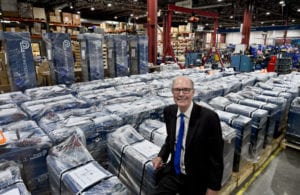A Look Back At CEO, Andy’s Marsh’s Quora Session
Back in March, CEO Andy Marsh took part in an open Quora session, where he answered questions from the public about Plug Power, hydrogen, and how innovative thinking can change the way we approach sustainable energy in the future. The Q&A session was wildly successful, with over 26,000 views and the re-publication of some of Andy’s answers to major news outlets. If you missed the Q&A, no problem—we’ve got you covered with a recap:
we approach sustainable energy in the future. The Q&A session was wildly successful, with over 26,000 views and the re-publication of some of Andy’s answers to major news outlets. If you missed the Q&A, no problem—we’ve got you covered with a recap:
Forbes and Apple News
What Is Preventing Widespread Adoption Of Hydrogen Fuel Cell Technology?
The electric mobility (e-mobility) use-case demands solutions that support high utilization and extended runtimes, perform reliably in harsh environments, fuel rapidly, and expel zero emissions. We’ve already created the first commercially-viable market for fuel cell electric vehicles (FCVs) in material handling, an industry with these same demands, so we’ve been working to address these obstacles for many years.
Some skeptics question the best use cases for FCVs. While electric vehicles win out for short-range applications, FCVs will ultimately win in asset-intensive applications, such as fleet vehicles, airplanes, drones, and autonomous vehicles that require continuous runtimes and lighter weight engines. Of course, one of the biggest challenges will be creating a robust infrastructure with enough hydrogen fueling stations to keep vehicles running around the clock. However, the benefits far outweigh the difficulties, and we expect to see widespread global expansion of hydrogen stations in the coming decade.
3 Secrets of Truly Innovative People
With decades of experience leading technology innovation, I’ve learned that it’s essential to keep the technology and talent at the forefront of all decisions in order to inspire continued innovation. Innovation starts with a fundamental concept – find a problem that needs to be fixed, and fix it.
Don’t be afraid to fail.
Innovation is hard work. Your team must be encouraged to put in the time and also to take chances. Sometimes, those chances result in failure. But, fail upwards. Every result is a path to another result. Giving your team the ability to “get it wrong the first time” inspires a culture of creativity and passion to continue innovating.
Set hard, yet achievable goals.
Goal setting is proven to have a positive impact; according to McKinsey, 91 percent of companies that have effective performance management systems say that employee goals are linked to business priorities. Give your team challenging, yet achievable targets to help push them in the right direction and encourage them to continue performing even when they’re dealing with the challenges of growing technology.
Motivate and inspire.
Adopting new technologies and processes can be challenging for employees, making it easy to lose motivation. It’s essential to the success of innovation to keep employees engaged and motivated. Research from 5 Dynamics says that happy employees are 20 percent more productive than unhappy employees. There are many ways to drive motivation, including team activities and goal setting. Find a mixture that works for your business and employees — old and new — and dedicate time to ensuring they feel fulfilled.
Innovation is fun, but comes with its on set of challenges. But one thing is certain – your innovators have spent time and energy building and growing something they believe in and the technology they’ve created ignited something great. Ensure employees understand the value of their talent and innovative spirit – encourage that passion and build something even stronger together.
How Are Hydrogen Fuel Cells Made?
A hydrogen fuel cell is an electrochemical power generator that combines hydrogen and oxygen to produce electricity, with water and heat as by-products. A fuel cell is composed of three main components: an anode, a cathode, and an electrolyte membrane. The “magic” of the PEM fuel cell is its proton exchange membrane, which looks like a piece of construction paper. It works by passing hydrogen through the anode side and oxygen through the cathode side. At the anode site, the hydrogen molecules are split into electrons and protons. The protons pass through the electrolyte membrane, while the electrons are forced through a circuit, generating an electric current and excess heat. At the cathode, the protons, electrons, and oxygen combine to produce water molecules. Fuel cells are very clean, with the only by-products of electricity creation being a little heat and water. Additionally, as HFCs do not have any moving parts, they operate very quietly.
It’s worth noting- it is possible to use both the heat and water by-products for additional functions. For example, current Plug Power GenDrive customers use the excess water in their floor scrubbers and for landscape hydration.
We’re encouraged by the public’s interest in these topics and look forward to future opportunities to continue our open dialogue with the public.